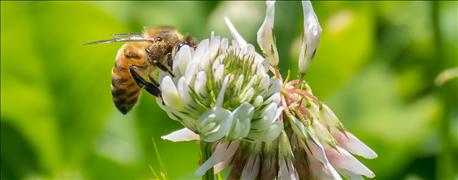
Roger Wenning burned down annual ryegrass earlier this spring and left crimson clover and other cover crops in the mix growing on purpose. Wenning, of Decatur County, wanted crimson clover to grow as long as possible.
Here is a short question-and-answer exchange with Wenning.
IPF: Why did you take out annual ryegrass early?
Wenning: I needed to get it before it got too big and became too hard to control. I did not have trouble taking it out at the end of April.
IPF: Why did you leave crimson clover growing?

CAUTION — BEES AT WORK: Honeybees were busy in the crimson clover field on Roger Wenning’s farm recently. (Photo: Entropyd/iStock/Thinkstock)
Wenning: It was a conscious decision to take out the ryegrass and not harm anything else. My son, Nick, and I wanted the clover to continue to grow. Our main idea was that the longer it grows, the more nitrogen it will produce since it is a legume.
IPF: What are the plans for this field this year?
Wenning: The plan was to plant corn and burn down the clover then. We no-till in twin rows with a Great Plains planter. Mother Nature threw us a curve with a long wet, cool spell in May. The clover grew even longer than we originally intended.
IPF: You commented just after you killed the ryegrass that you felt certain that the crimson clover was a plus for pollinators. Is that important?
Wenning: It’s another benefit you can get from a cover crop like crimson clover that flowers. We realize that how much pollinator activity you get depends upon how long you can let the clover grow, and how well it blooms.
IPF: Since you had to leave the crimson clover for an extended period since Mother Nature didn’t cooperate, did you see the activity from honeybees that you expected?
Wenning: Yes. During the first couple of weeks we were curious about how much activity was occurring out there, but weren’t sure how to quantify it. We felt certain that bees were visiting the field with crimson clover still growing, and that it was beneficial for them.
IPF: You recently reported some numbers and passed along some pictures of bees at work in the field. What did you find?
Wenning: We began noticing more activity, with more bees pollinating crimson clover flowers in the field. As best we could, we decided to count the number of bees in a given area. Nick took pictures to document what we saw at the same time that we did some counts.
IPF: How did the counting come out?
Wenning: In the spot where Nick took pictures, we counted the number of bees we found in 15 feet of row area. We pegged it at 42 bees. To us, that seems like a lot of pollination activity going on in the field. We feel like it’s positive for bees to be able to feed on something like crimson clover this early in the season. We realize that this spring was unusual, and the clover was left longer than it might be in future years, but what we saw was exciting.
About the Author(s)
You May Also Like




